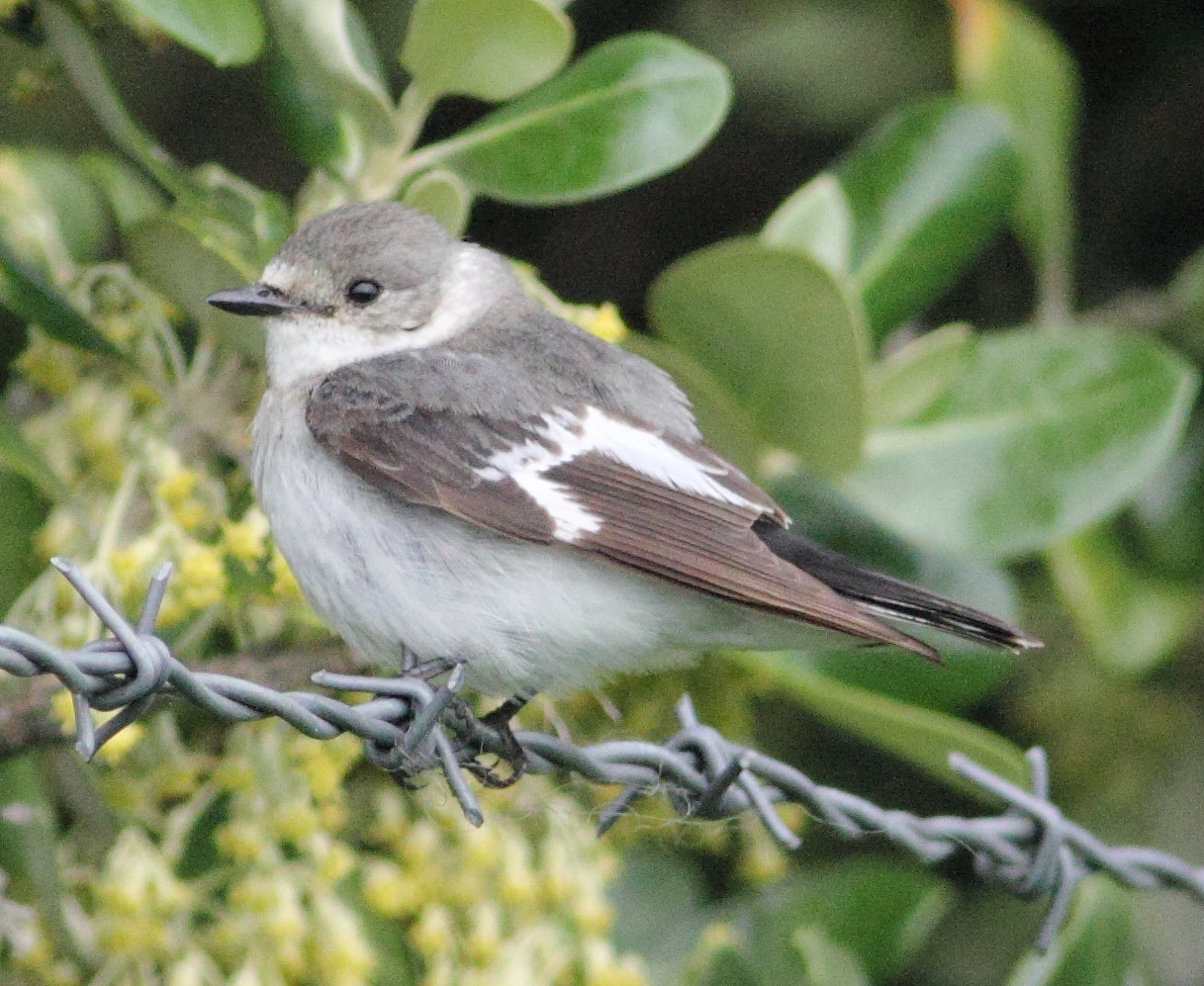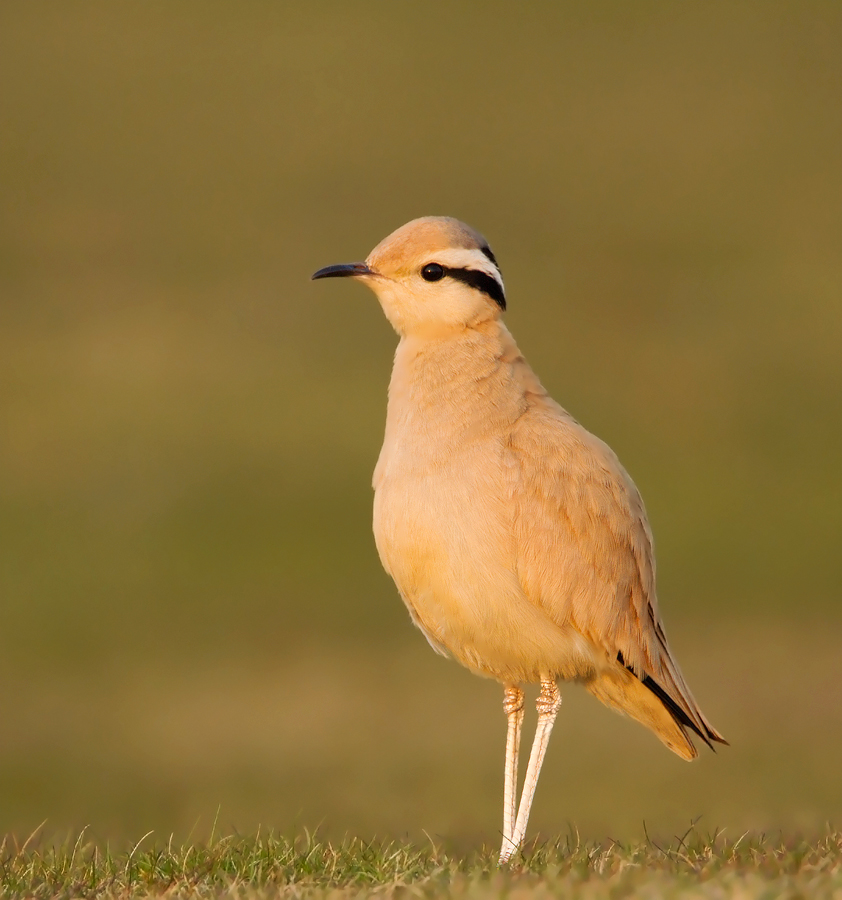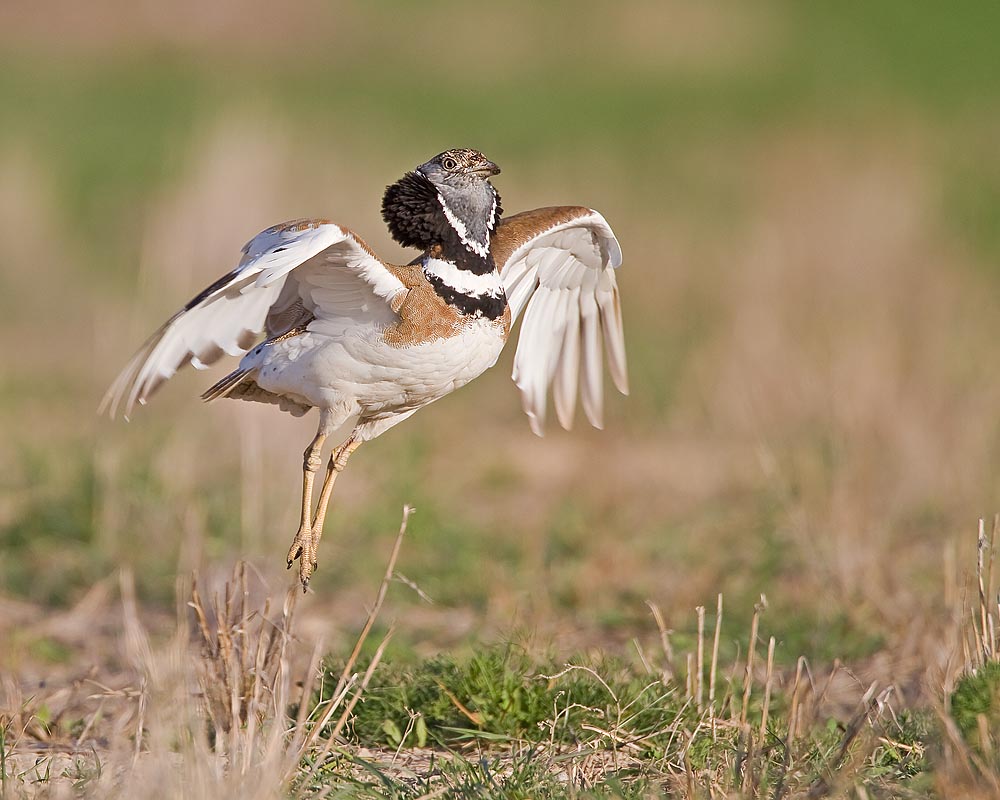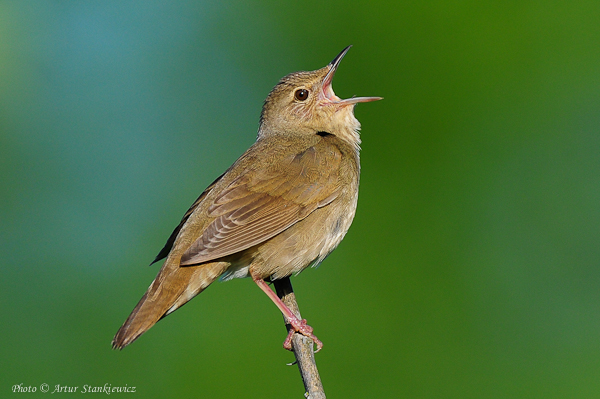The week at a glance
- Western Orphean Warbler in Cleveland
- Ireland's first Collared Flycatcher graces Donegal
- Roller in East Yorkshire
- Baillon's Crake still singing on Anglesey
- Bonaparte's Gull double in London
- Good numbers of Black Kites and Bee-eaters, and Red-footed Falcons begin to arrive
With warm and sunny conditions continuing to combine with an easterly airflow, it was another great week to be out in the field across much of Britain and Ireland. Following last week's Cream-coloured Courser and Baillon's Crake, many might have accepted that the birds of the spring had already fallen, although the conditions kept plenty of hopes raised for one final bang. And, sure enough, it came during the morning of 29th.
Given how close they breed to our shores, it always seems surprising just how rare Orphean Warblers — either Eastern or Western — are in the British Isles. With just five accepted records (of which only one has been confidently assigned to [sub]specific level), the last gettable bird was that on Scilly as far back as 1981. So, when a first-summer male Western Orphean Warbler was extracted from a local's mist-net, Hartlepool Headland (Cleveland) braced itself for lightning to strike twice. By late morning, the crowd had swelled to impressive proportions, with bemused locals no doubt suffering a severe sense of déjà vu in light of June 2011's White-throated Robin. However, unlike the robin, the warbler gave itself up rather easily at the Bowling Green throughout the day, rendering a Lord of the Rings-style siege on the Doctor's Garden unnecessary. Frustratingly for those who could not escape work that day, the bird had moved on (or perhaps succumbed) by the following morning. As an aside, it would be interesting to know how many headed to the northeast with stepladders in their vehicles...

Western Orphean Warbler, Hartlepool Headland, Cleveland (Photo: Martyn Sidwell)

Western Orphean Warbler, Hartlepool Headland, Cleveland (Photo: Richard Jackson)
Ireland also delivered its very own monster on 29th: a first-summer male Collared Flycatcher on Tory Island (Donegal). Although the species has become something of an annual fixture in Britain in recent years, this peculiar, greyish individual represents the first Irish record! Evidently a first-summer from its brownish wings, the bird was initially identified as a female but, due to the amount of white splashed about the tertials and coverts, assigning it to the fairer sex simply didn't add up. In addition, an apparent 'ghosting' of a collar and the odd bit of black dotted about the upperparts suggested that this was a male, albeit an abnormal one. In light of recent Ficedula-related revelations, this is a great find indeed.

Collared Flycatcher, Tory Island, Donegal (Photo: Peter Phillips)
In other weeks, the vivid adult Roller at Spurn then Kilnsea (E Yorks) during the morning of 29th could have grabbed the headlines but, with two top-class birds stealing the show, it was reduced to a quality 'also-ran'. The same could also be said for the male Baillon's Crake, still singing overnight at Malltraeth Marsh (Anglesey) to 29th at least, while the continuing Greater Yellowlegs at Loch of Strathbeg (Aberdeenshire) hardly got a look in.

European Roller, Spurn, East Yorkshire (Photo: Martin Garner)
The hot, anticyclonic conditions experienced throughout the week predictably resulted in strong showings of several of the classic 'flyover species'. Well over 30 Bee-eaters were clocked as far north as Cumbria, with Cleveland and North Yorkshire also claiming flyovers. A group of six over Bradwell, Eccles and Waxham (Norfolk) on 25th–26th were never pinned down, and there were also reports of six over The Naze (Essex) on 26th and five over Minsmere (Suffolk) on 28th, which may or may not involve the same birds. Other 'groups' included three over Sholden (Kent) on 24th, and twos in East Sussex and Norfolk.
Also doing well were Black Kites: 18 reports on Bird News Extra throughout the week stretched from Kent to Cumbria, although all were typically fleeting as they restlessly drifted around in the warm May sunshine. Among the few that were tracked at least partially were birds over Bardsey Island then Uwchmynydd (Gwynedd) on 26th, and at Blakeney (Norfolk) on 25th and again on 29th. The sight of one coming to roadkill near Whitcombe (Dorset) on 25th must have been a surprise for the observer. As anticipated, the number of Red-footed Falcons also increased, with seven birds noted. Two Irish records came from Owenahincha (Cork) and Tacumshin (Wexford), the latter lingering all week. British birds were typically biased towards the south and east, with records from East Yorkshire, Norfolk, Suffolk, Cambridgeshire and Essex. A male Pallid Harrier flying north at Long Buckby then West Haddon (Northants) during the evening of 28th could prove to be the final bird of a productive spring for the species. Not quite as seasonably, the Snowy Owl remained on North Uist to 26th at least.
A drake American Wigeon was a new arrival to Haroldswick, Unst (Shetland) on 24th–26th, with a female there on 24th and a further pair reported at Gutcher, Yell the same day. Otherwise, vagrant wildfowl were limited to a first-summer drake Surf Scoter at the mouth of Loch Gairloch (Highland) on 30th, while the Aberdeenshire King Eider moved south to Murcar Golf Course from 28th. The sole White-billed Diver record concerned a summer-plumaged beauty off Sumburgh Head (Shetland) on 28th.

American Wigeon, Haroldswick, Unst, Shetland (Photo: Mike Pennington)
A Squacco Heron at Dungeness (Kent) on 30th was presumably fresh in from the continent, while the scant showing of Purple Herons continued, with two further untwitchable birds over Plymouth (Devon) and at Lakenheath Fen (Suffolk) on 28th. Away from the small breeding contingent on the Somerset Levels (where the youngster has been seen wing-stretching!), around five Great White Egrets included a lingering bird at Thurlestone Marsh (Devon) on 24th–28th and at least two in Norfolk. The Cattle Egret flying west over West Bexington (Dorset) was presumably that flying over Seaton (Devon) later in the morning, and may also account for one in the Yelland/Isley Marshes area on 25th–27th.

Great White Egret, Ham Wall RSPB, Somerset & Bristol (Photo: Jeff Hazell)
Around ten Glossy Ibises were typically spread from Wexford eastwards across southern areas of Wales and England, with two in the Pannel Valley (E Sussex) on 25th–26th presumably those touring the Suffolk coast between North Warren and Minsmere on 29th–30th. Apart from a couple of presumed escapes touring Clyde and Worcestershire, White Stork records were reduced to the continued roaming of the flock of four. Flying over Meare Heath (Somerset) on 24th, they were in South Devon over the Kingsbridge Estuary the next day, presumably still searching for a suitable site from which to cross the Channel. Rather remarkably, however, they were next noted drifting over Lakenheath Fen (Suffolk) during the afternoon of 28th! Presumably they are now lurking somewhere in the depths of East Anglia.

Glossy Ibis, Pagham Harbour LNR, West Sussex (Photo: Iml)
Following a quieter week last week, a resurgence of Black-winged Stilt records was confused by a number of mobile birds. The first of the week was a bird reported at Yelland (Devon) on 24th, with two others found down the road from each other at Lodmoor and Abbotsbury (Dorset) the same day, and a fourth pitching down briefly at Paxton Pits (Cambs) that evening. The two Dorset birds remained until 25th and 27th respectively, with another found at Newport Wetlands (Gwent) on 25th. Birds at Exminster Marshes (Devon) and Farlington Marshes (Hants) on 27th–29th could feasibly be the two Dorset individuals relocating, although the latter looks decidedly similar to the recent Frampton Marsh bird, thus meaning it could be the same as that seen at Paxton on 24th! Just to add to the complex, records from Hodbarrow (Cumbria) on 28th, Shibdon Pond (Durham) briefly on 29th, and Fairburn Ings (W Yorks) on 30th appear to relate to one and the same bird. Phew...comments welcome!

Black-winged Stilt, Pennington Marshes, Hampshire (Photo: Joe Stockwell)
Otherwise, it was a much better week for wader variety. The first Broad-billed Sandpiper of 2012 was a brief visitor to Loch Bee, South Uist (Outer Hebrides) on 28th, with a Buff-breasted Sandpiper at the Butt of Lewis the previous day. Five one-day Pectoral Sandpipers visited Galway, Mayo, Orkney, Devon and West Yorkshire, while yet another Long-billed Dowitcher dropped in at Saltholme Pools (Cleveland) on 24th–25th. Gloucestershire's Red-necked Phalarope was still at Coombe Hill Meadows intermittently to 29th, with another sharing the Inishkea Islands (Mayo) on 25th with one of the aforementioned Pec Sands.

Broad-billed Sandpiper, Loch Bee, S.Uist, Outer Hebrides (Photo: Steve Duffield)
Avoiding the temptation to make predictable comparisons to the capital's bus system, London (and, more specifically, Cross Ness) scored a remarkable second Bonaparte's Gull in a week on 26th. Another first-summer, the bird displayed a more advanced state of moult than its predecessor, which was seen again from 27th. Both birds were seen on 29th (though not together), while an adult was new at Loch of Tingwall (Shetland) on 30th.

Bonaparte's Gull #1, Cross Ness, Greater London (Photo: Andrew Moon)

Bonaparte's Gull #2 (rear) with Black-headed Gull, Cross Ness, Greater London (Photo: Josh Jones)
The first collectable White-winged Black Terns of 2012 arrived over the weekend: two were at Stodmarsh (Kent) throughout the day on 26th, and a third — a second-summer — at Saltholme Pools (Cleveland) the following day. In Wexford, the Forster's Tern remained at Tacumshin throughout the week, while a Caspian Tern flew south past Kinnaird Head (Aberdeenshire) on 27th and a Gull-billed Tern was at Thorne Moors (S Yorks) for the afternoon and evening of 30th.

White-winged Black Tern, Saltholme RSPB, Cleveland (Photo: Ian Forrest)
Down on Scilly, the Short-toed Lark lingered on St. Mary's to 24th only, although it was replaced by another on St. Martin's on 30th, and a third was on the Farne Islands (Northumberland) on 27th–29th. The only Tawny Pipit report concerned a flyover at Capel-le-Ferne (Kent) on 28th, while all of the six Hoopoes reported were brief. Plenty of Golden Orioles were still parading around much of the country, and included five at Spurn (E Yorks) on 25th. Five Red-rumped Swallows included two at Skaw, Unst (Shetland) on 25th and another at Blacksod (Mayo) the following day. Others were brief visitors to Scilly and Norfolk.

Red-rumped Swallow, Skaw, Unst, Shetland (Photo: Mike Pennington)
Belated news from Weybourne (Norfolk) concerned a Thrush Nightingale trapped and ringed there on 20th, while birds on Fair Isle on 25th and the Isle of May (Fife) on 30th went through a similar process. Red-spotted Bluethroats were vastly reduced to just a few birds, including birds on Holy Island (Northumberland) and Blakeney Point (Norfolk). Four Subalpine Warblers included just one attributed to race: a male Eastern briefly on Tiree (Argyll) during the afternoon of 28th. Others involved a female on Fair Isle on 26th and two males on Lundy (Devon) on 30th. Four Greenish Warblers were located between Guernsey and East Yorkshire on 25th–26th, and included a singing male at Northward Hill (Kent). A fifth was on Cape Clear (Cork) on 30th. An Iberian Chiffchaff was singing at Kenidjack Valley (Cornwall) from 28th, although a 'possible' reported from the Eildon Hills (Borders) on 24th was not confirmed.

Greenish Warbler, Pezeries, Guernsey (Photo: Mark Guppy)
A singing male Great Reed Warbler was new in at Cley Marshes (Norfolk) on 30th, and others remained at Radipole Lake to 24th and the sewage works at Weston-super-Mare (Somerset) throughout. In another good spring for the species, a singing Savi's Warbler was located at Blacktoft Sands (E Yorks) on 29th — even accounting for the possibility of a more liberal attitude towards releasing news of this species, there does seem to have been a genuine upturn in the number of records since the early and mid–2000s.

Great Reed Warbler, Weston-super-Mare SW, Somerset & Bristol (Photo: Joe Stockwell)
Belated news of an impressive ten Icterine Warblers on Fair Isle on 23rd essentially blew away competition from other sites, although North Ronaldsay managed four on 24th. The other 20 or so were well scattered in ones and twos, from Portland (Dorset) north to the Shetland mainland. It was also a productive week for Marsh Warbler records, with 43 reports received at Bird News Extra. Among the brief east-coast migrants, lingering singers included birds at Cleethorpes (Lincs) from 28th and Blacktoft Sands (E Yorks) from 29th, while two different birds were trapped at Landguard (Suffolk) on 28th and 29th; the former was Dutch-ringed and is the first Dutch control of the species in Britain. Three British Red-breasted Flycatchers were in Kent, Northumberland and Fife, while an Irish bird staged on Dursey Island (Cork) on 25th–26th.

Marsh Warbler, Quendale, Mainland, Shetland (Photo: James Wood)

Icterine Warbler, Filey, North Yorkshire (Photo: Mark Pearson)
The southwest continued to dominate Woodchat Shrike records. One on Tresco (Scilly) on 24th was followed by two new Cornish birds at Treve Common on 27th and St. Levan on 28th, although a male at Maghull (Lancs) on 30th bucked the trend. In Ireland, a male was found on Sherkin Island (Cork) on 30th. Red-backed Shrikes remained plentiful, with as many as 50 scattered across Britain and Ireland. The majority were in the Northern Isles (particularly Shetland): Fair Isle claimed nine on 23rd, and North Ronaldsay held eight the following day. Three Irish records came from in Wexford (2) and Dublin, while there was light scattering of birds along the British east coast. Adult Rose-coloured Starlings were brief visitors to Landguard (Suffolk) on 25th and Arlington Reservoir (E Sussex) on 27th.

Red-backed Shrike, Barns Ness, Lothian (Photo: Peter M. Macdonald)

Red-backed Shrike, Warham, Norfolk (Photo: Craig Shaw)
Also at Landguard, the female Serin reappeared again on 30th: this is at least the third week it has been present. Others flew over Colkirk (Norfolk) and Berry Head (Devon). Perhaps as many as 15 Common Rosefinches were well scattered; a red male singing at Meenbannad (Donegal) during the afternoon of 28th was perhaps the star find.

Common Rosefinch, Meenbannad, Donegal (Photo: Tony Gallagher)
A singing male Rustic Bunting at Sumburgh Head (Shetland) must have been a delight both to look at and to listen to during its four-day stay from 24th, with another nearby at Scousburgh on 26th. Arguably even better-looking were the week's two male Black-headed Buntings. A bird on Bryher (Scilly) on 28th lingered for the day only, but another at Gloup, Yell (Shetland) during the afternoon of 29th was still there the following morning.

Black-headed Bunting, Gloup, Yell, Shetland (Photo: Dougie Preston)
Photo of the Week

Puffin, Farne Islands, Northumberland (Photo: Morgan)
In the right locations and at the right times of year, Puffins can be among the most approachable of wild birds. The Farne Islands in spring are one such combination and have been the source of many excellent photos uploaded to our website. This week, Morgan Stephenson got in ahead of this year's pack with an early head-and-shoulders shot that brings out all the unique facial features of this distinctive species. In fact, we haven't had a Puffin Photo of the Week for almost three years, and this is Morgan's first PotW, so it's good to have been able to kill two birds with one stone (excuse the inappropriate idiom). In Morgan's image, the head-back displaying posture creates wonderful shapes and removes the 'dismissing effect' of our brain's pattern-matching so that we can appreciate afresh the intricate eye, bill and plumage details. A perfect illustration of the interest that can be created through the use of a different angle on a familiar subject.
Other notable photos

Spotted Flycatcher, undisclosed site, Shropshire (Photo: John Fielding)

Cream-coloured Courser, Bradnor Hill, Herefordshire (Photo: Carl Day)

Little Owl, undisclosed site, Lancashire (Photo: Austin Thomas)

Cuckoo, undisclosed site, Glamorgan (Photo: Raymond King)

Little Bustard, Spain (Photo: Garth Peacock)

European Bee-eater, Cyprus (Photo: Russell Hayes)

Grey Partridge, Fressingfield, Suffolk (Photo: Jon Evans)

Common Whitethroat, Westward Ho!, Devon (Photo: Rob Cross)

River Warbler, Poland (Photo: Artur Stankiewicz)

Common Snipe, undisclosed site, Outer Hebrides (Photo: Gerhard)

Northern Wheatear, Ardnave, Islay, Argyll (Photo: Mark Hancox)

European Stonechat, Wayoh Reservoir, Lancashire (Photo: John Barlow)

Pomarine Skua, Aird an Runair, N.Uist, Outer Hebrides (Photo: Ian Andrews)

Yellow Wagtail, Torness Power Station, Lothian (Photo: Mike Thrower)

Common Redstart, undisclosed site, Worcestershire (Photo: Mr Clive Daelman)

House Martin, Salehurst, East Sussex (Photo: Will Rawles)

Black Tern, Elton Reservoir, Greater Manchester (Photo: A.Dancy)

Nuthatch, Gilfach Farm NR, Powys (Photo: Steve)

Tufted Duck, Bushy Park, Greater London (Photo: Mohammed Al-Najar)


